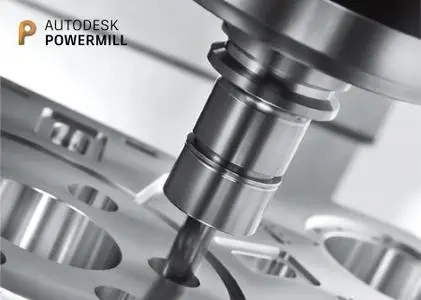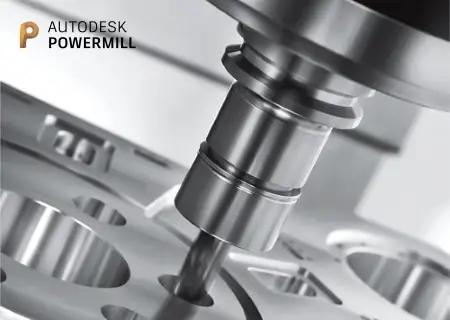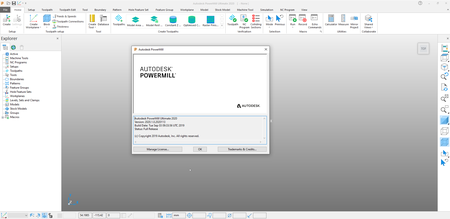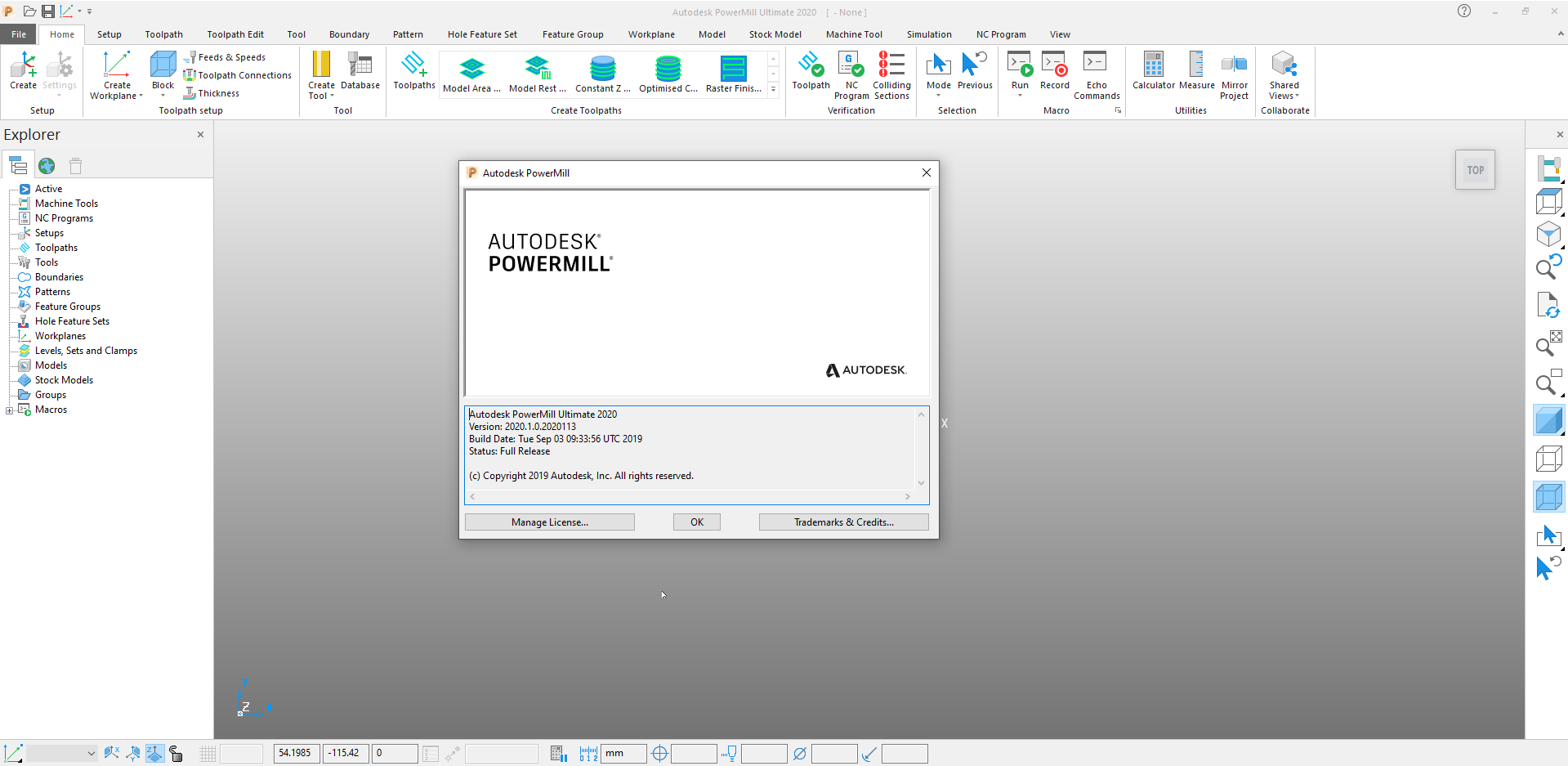Autodesk Powermill 2020.1 Update | 258.4 mb
Languages: 中文 Simplified, 中文 Traditional, Čeština, english, Français, Deutsch, Magyar,
Italiano, 日本語, 한국어, Polski, Português, Русский, Slovenčina, Español, Türkçe
Languages: 中文 Simplified, 中文 Traditional, Čeština, english, Français, Deutsch, Magyar,
Italiano, 日本語, 한국어, Polski, Português, Русский, Slovenčina, Español, Türkçe
The Autodesk NC CAM team has launched the new release PowerMill 2020.1. The last release of PowerMill represents a significant shift in development in recent years – with a clear focus on usability, reliability, and speed.
Model filleting improvements
- Model filleting for all 3-axis strategies: You can now use model filleting when creating toolpaths for 3-axis strategies, such as Pattern Finishing and 3D Offset Finishing, to fillet the model before calculation. This can help reduce sharp turns in internal corners, to produce a better surface finish and reduce the risk of tool breakages.
Speed improvements
- Collision avoidance: Performance for toolpaths that have Automatic Collision Avoidance selected is improved, meaning toolpaths now calculate faster.
- Corner finishing: Improvements are made to the speed at which toolpaths are calculated for the Corner Finishing strategy.
- Area clearance and rest finishing: Toolpath strategies used for area clearance and rest finishing now calculate faster.
Additional improvements
- Model export options: You can now export models to a wider range of file formats, to make it easier to transfer models to Autodesk Fusion 360 and other 3rd party systems. Formats include Additive Manufacturing (.amf), 3D Manufacturing (.3mf), Fusion Modeling Data (.smt), and others (.stp, .step, .ig, .3dm, .sat, .obj, .pdf).
- Clearer NC program statuses: The icons in the Explorer for an NC program are updated, to make the statuses of NC programs clearer. When you postprocess an NC program, its icon changes from to . If afterwards you modify the NC program, its icon changes to .
- Manage multiple folders: In the Explorer, you can now move and delete multiple folders at the same time.
- Extend availability of optimised parallel passes: Optimise Parallel Pass is now available for the Raster Finishing strategy where Automatic Collision Avoidance is selected, and the Tool Axis is set to Vertical.
- Resizable dialog for choosing posts: You can now resize the Select Option File dialog when choosing a post processor, so you can view more information with less scrolling.
Toolpaths
- Fixed an issue that caused arc leads and links to be polygonized when using a constant orientation vector.
- Fixed an issue that prevented arc moves from being written out as arcs when using orientation vectors and cutter compensation.
- Fixed an issue that caused the safety status of a toolpath to change after choosing to draw colliding sections on a toolpath where the tool included not a shank or a holder.
- Improvements have been made to how box-shaped safe areas are used to define safe links.
- Drilling positions in Area Clearance no longer persist between projects in the same session.
- Fixed failures to apply Raceline Smoothing.
- Fixed an occurrence of a gouge in Offset Area Clearance
- Duplicate hole recognition of composite holes made more robust.
- Better limit finishing toolpaths when using a triangle block.
- Cloning a toolpath in PowerMill Premium or PowerMill Standard no longer strips out user-defined parameters.
- When a model is imported, and Calculated Toolpaths And Boundaries Ignore New Models is selected in the Import page of the Options dialog, PowerMill now sets the -model to be a reference model on all calculated toolpaths. If a calculated toolpath was active, there was previously an issue where the model was not being displayed as a reference.
- Fixed an issue where it was not possible to limit a toolpath to a polygon after selecting the Top face from the ViewCube.
- Fixed an issue with corner filleting that could cause the appearance of vertical spikes of air cutting moves.
- Fixed an issue that could cause an incomplete toolpath to be calculated when using the Unsafe Segment Removal option.
- Fixed an issue that could cause an incomplete toolpath to be calculated when using the Unsafe Segment Removal option with ramps.
- Fixed a problem that caused PowerMill to close unexpectedly when collision checking a toolpath.
- Fixed a problem that caused PowerMill to close unexpectedly when calculating an Optimised Constant Z Finishing toolpath.
- Fixed a problem that could cause PowerMill to close unexpectedly while calculating the leads and links in a toolpath if the rotary axis configuration was defined using a machine tool.
- Fixed a problem that could cause data required for cutter compensation to be lost when a toolpath was verified or edited.
- Fixed a problem that prevented cutter compensation from being turned on and off correctly.
- Fixed a problem that prevented cutter compensation from being applied to a toolpath whose orientation vectors had been edited using Dynamic Machine Control.
- Fixed a problem that could result in spikes and deviations in the offsets of a 3D Offset Finishing toolpath.
- Fixed a problem that could result in a Steep and Shallow Finishing toolpath that did not follow the desired Top First ordering.
- Fixed a problem that could result in gouges when calculating a Constant Z toolpath with arc-fitting and automatic collision checking.
- Fixed a problem that could prevent a toolpath from being calculated when using automatic collision avoidance.
- Fixed problems that prevented automatic collision avoidance from avoiding a collision.
- Fixed a problem that could result in small fluctuations of the tool axis elevation when using automatic collision avoidance.
- Fixed a problem that prevented selective editing of leads and links when using an orientation vector defined by the direction of travel.
- Fixed a problem that prevented circular arc links from being added when editing the start points of a toolpath that used a fixed tool-axis elevation.
Machine tool simulation
- Improved accuracy of machine-tool simulation in PowerMill when used together with Autodesk Manufacturing Post Processor Utility 2020.0.1, as both now use the same axis mode
- Correct machine positions are now simulated when the VALUE in the MTD file is different from the initial position in the associated .pmoptz file for rotary axes.
- When an option file is associated with a machine tool, the machine is now reset before simulating a toolpath based on the ResetAxes flag in the option file.
- Fixed the detection of machine axis limit issues in linearised positions inserted by the postprocessor, based on the option file associated with the machine tool.
- Fixed an issue where simulation would ignore the orientation vectors set in the Dynamic Machine Control.
- Fixed an issue that meant a machine could not be associated with an option file despite the limits being identical.
Patterns
- Fixed an issue where patterns would no longer be able to be drawn after activating different flowline toolpaths with the toolpath strategy dialog open.
- Fixed an issue where a pattern created using the Create Composite Curve toolbar through the Chamfer Milling strategy was not being analysed for machining sections.
- Fixed an issue where the curves in a pattern entity disappeared and became unselectable for assignment as machining patterns for 2D toolpaths.
Hole feature sets
- Dragging and dropping a hole from one Hole Feature Set to another in the Explorer no longer produces a command warning.
- If a hole is moved to another Hole Feature Set in the Explorer, the hole is not renamed unless the name is already taken in the new Hole Feature Set.
General
- An issue that could slow PowerMill down when showing operation progress has been fixed. This should particularly improve the speed of importing models.
- Fixed some translation issues within the Database Manager dialog, which previously displayed only in English.
- Fixed an issue where PowerMill would display an error when attempting to add multiple tools with the same holder to the tool database.
- Fixed an issue where PowerMill closed unexpectedly when reading in a project containing corrupted setup entities.
- Pressing Apply in the Thickness Preferences dialog no longer tries to modify the current toolpath.
- PowerMill and Autodesk PowerShape no longer override each other’s settings for the 3Dconnexion SpaceMouse.
- Fixed an issue where creating a workplane from a revolved surface was using too coarse a tolerance to position the workplane.
- Added a parameter function get_index in the macro language, which returns the index of an entry in a given list or array.
- Improved the export to Shared Views so a model containing surfaces that fail to shade do not prevent all the others from displaying correctly.
- Fixed an issue in the Curve Editor that was causing a significant delay when performing a box selection of points in a curve segment.
- Improved the time to open the Select Option File dialog and its responsiveness, particularly when there are lots of cloud option files.
- Fixed an issue where a model import would fail when the model had been exported from PowerMill after writing a surface inspection NC toolpath.
- Added a parameter function to get the current version numbers.
- Fixed an issue where the NC Program status icon did not always update immediately when toolpath parameters were modified.
Customer error reporting (CER)
- Fixed an issue that caused PowerMill to close unexpectedly when opening a toolpath containing a probe that was the currently active tool. This issue was identified by CER.
- Fixed an issue that caused PowerMill to occasional close unexpectedly when displaying an error message. This issue was identified by CER.
- Fixed an issue that caused PowerMill to close unexpectedly resulting from a failing tool database query involving tags. This issue was identified by CER.
- Fixed a problem that caused PowerMill to close unexpectedly when using Dynamic Machine Control to edit the tool axis on arc-fitted toolpath. This issue was identified by CER.
- Model filleting for all 3-axis strategies: You can now use model filleting when creating toolpaths for 3-axis strategies, such as Pattern Finishing and 3D Offset Finishing, to fillet the model before calculation. This can help reduce sharp turns in internal corners, to produce a better surface finish and reduce the risk of tool breakages.
Speed improvements
- Collision avoidance: Performance for toolpaths that have Automatic Collision Avoidance selected is improved, meaning toolpaths now calculate faster.
- Corner finishing: Improvements are made to the speed at which toolpaths are calculated for the Corner Finishing strategy.
- Area clearance and rest finishing: Toolpath strategies used for area clearance and rest finishing now calculate faster.
Additional improvements
- Model export options: You can now export models to a wider range of file formats, to make it easier to transfer models to Autodesk Fusion 360 and other 3rd party systems. Formats include Additive Manufacturing (.amf), 3D Manufacturing (.3mf), Fusion Modeling Data (.smt), and others (.stp, .step, .ig, .3dm, .sat, .obj, .pdf).
- Clearer NC program statuses: The icons in the Explorer for an NC program are updated, to make the statuses of NC programs clearer. When you postprocess an NC program, its icon changes from to . If afterwards you modify the NC program, its icon changes to .
- Manage multiple folders: In the Explorer, you can now move and delete multiple folders at the same time.
- Extend availability of optimised parallel passes: Optimise Parallel Pass is now available for the Raster Finishing strategy where Automatic Collision Avoidance is selected, and the Tool Axis is set to Vertical.
- Resizable dialog for choosing posts: You can now resize the Select Option File dialog when choosing a post processor, so you can view more information with less scrolling.
Toolpaths
- Fixed an issue that caused arc leads and links to be polygonized when using a constant orientation vector.
- Fixed an issue that prevented arc moves from being written out as arcs when using orientation vectors and cutter compensation.
- Fixed an issue that caused the safety status of a toolpath to change after choosing to draw colliding sections on a toolpath where the tool included not a shank or a holder.
- Improvements have been made to how box-shaped safe areas are used to define safe links.
- Drilling positions in Area Clearance no longer persist between projects in the same session.
- Fixed failures to apply Raceline Smoothing.
- Fixed an occurrence of a gouge in Offset Area Clearance
- Duplicate hole recognition of composite holes made more robust.
- Better limit finishing toolpaths when using a triangle block.
- Cloning a toolpath in PowerMill Premium or PowerMill Standard no longer strips out user-defined parameters.
- When a model is imported, and Calculated Toolpaths And Boundaries Ignore New Models is selected in the Import page of the Options dialog, PowerMill now sets the -model to be a reference model on all calculated toolpaths. If a calculated toolpath was active, there was previously an issue where the model was not being displayed as a reference.
- Fixed an issue where it was not possible to limit a toolpath to a polygon after selecting the Top face from the ViewCube.
- Fixed an issue with corner filleting that could cause the appearance of vertical spikes of air cutting moves.
- Fixed an issue that could cause an incomplete toolpath to be calculated when using the Unsafe Segment Removal option.
- Fixed an issue that could cause an incomplete toolpath to be calculated when using the Unsafe Segment Removal option with ramps.
- Fixed a problem that caused PowerMill to close unexpectedly when collision checking a toolpath.
- Fixed a problem that caused PowerMill to close unexpectedly when calculating an Optimised Constant Z Finishing toolpath.
- Fixed a problem that could cause PowerMill to close unexpectedly while calculating the leads and links in a toolpath if the rotary axis configuration was defined using a machine tool.
- Fixed a problem that could cause data required for cutter compensation to be lost when a toolpath was verified or edited.
- Fixed a problem that prevented cutter compensation from being turned on and off correctly.
- Fixed a problem that prevented cutter compensation from being applied to a toolpath whose orientation vectors had been edited using Dynamic Machine Control.
- Fixed a problem that could result in spikes and deviations in the offsets of a 3D Offset Finishing toolpath.
- Fixed a problem that could result in a Steep and Shallow Finishing toolpath that did not follow the desired Top First ordering.
- Fixed a problem that could result in gouges when calculating a Constant Z toolpath with arc-fitting and automatic collision checking.
- Fixed a problem that could prevent a toolpath from being calculated when using automatic collision avoidance.
- Fixed problems that prevented automatic collision avoidance from avoiding a collision.
- Fixed a problem that could result in small fluctuations of the tool axis elevation when using automatic collision avoidance.
- Fixed a problem that prevented selective editing of leads and links when using an orientation vector defined by the direction of travel.
- Fixed a problem that prevented circular arc links from being added when editing the start points of a toolpath that used a fixed tool-axis elevation.
Machine tool simulation
- Improved accuracy of machine-tool simulation in PowerMill when used together with Autodesk Manufacturing Post Processor Utility 2020.0.1, as both now use the same axis mode
- Correct machine positions are now simulated when the VALUE in the MTD file is different from the initial position in the associated .pmoptz file for rotary axes.
- When an option file is associated with a machine tool, the machine is now reset before simulating a toolpath based on the ResetAxes flag in the option file.
- Fixed the detection of machine axis limit issues in linearised positions inserted by the postprocessor, based on the option file associated with the machine tool.
- Fixed an issue where simulation would ignore the orientation vectors set in the Dynamic Machine Control.
- Fixed an issue that meant a machine could not be associated with an option file despite the limits being identical.
Patterns
- Fixed an issue where patterns would no longer be able to be drawn after activating different flowline toolpaths with the toolpath strategy dialog open.
- Fixed an issue where a pattern created using the Create Composite Curve toolbar through the Chamfer Milling strategy was not being analysed for machining sections.
- Fixed an issue where the curves in a pattern entity disappeared and became unselectable for assignment as machining patterns for 2D toolpaths.
Hole feature sets
- Dragging and dropping a hole from one Hole Feature Set to another in the Explorer no longer produces a command warning.
- If a hole is moved to another Hole Feature Set in the Explorer, the hole is not renamed unless the name is already taken in the new Hole Feature Set.
General
- An issue that could slow PowerMill down when showing operation progress has been fixed. This should particularly improve the speed of importing models.
- Fixed some translation issues within the Database Manager dialog, which previously displayed only in English.
- Fixed an issue where PowerMill would display an error when attempting to add multiple tools with the same holder to the tool database.
- Fixed an issue where PowerMill closed unexpectedly when reading in a project containing corrupted setup entities.
- Pressing Apply in the Thickness Preferences dialog no longer tries to modify the current toolpath.
- PowerMill and Autodesk PowerShape no longer override each other’s settings for the 3Dconnexion SpaceMouse.
- Fixed an issue where creating a workplane from a revolved surface was using too coarse a tolerance to position the workplane.
- Added a parameter function get_index in the macro language, which returns the index of an entry in a given list or array.
- Improved the export to Shared Views so a model containing surfaces that fail to shade do not prevent all the others from displaying correctly.
- Fixed an issue in the Curve Editor that was causing a significant delay when performing a box selection of points in a curve segment.
- Improved the time to open the Select Option File dialog and its responsiveness, particularly when there are lots of cloud option files.
- Fixed an issue where a model import would fail when the model had been exported from PowerMill after writing a surface inspection NC toolpath.
- Added a parameter function to get the current version numbers.
- Fixed an issue where the NC Program status icon did not always update immediately when toolpath parameters were modified.
Customer error reporting (CER)
- Fixed an issue that caused PowerMill to close unexpectedly when opening a toolpath containing a probe that was the currently active tool. This issue was identified by CER.
- Fixed an issue that caused PowerMill to occasional close unexpectedly when displaying an error message. This issue was identified by CER.
- Fixed an issue that caused PowerMill to close unexpectedly resulting from a failing tool database query involving tags. This issue was identified by CER.
- Fixed a problem that caused PowerMill to close unexpectedly when using Dynamic Machine Control to edit the tool axis on arc-fitted toolpath. This issue was identified by CER.
PowerMill is Autodesk’s CAM solution for high-speed and five-axis machining. It offers a comprehensive range of strategies and powerful editing tools to ensure efficient, safe and accurate machining, especially for companies that are using sophisticated CNC machine tools to produce complex shapes in challenging materials. PowerMill is used in a wide range of industries but is particularly successful in mold, tool and die, complex aerospace and automotive applications.
The release of PowerMill 2020 represents a significant shift in development in recent years – with a clear focus on usability, reliability, and speed.
The previous releases of PowerMill have seen significant improvements in terms of robustness and safety. Technology such as collision avoidance using automatic tool-axis tilting makes it easier for CAM programmers to create safe NC code that can be run on their CNC machines. Autodesk’s pursuit of safe, collision-free toolpaths has resulted in the introduction of additional safety checks within the core PowerMill algorithm. These safety checks are a good thing – but they do carry a processing overhead which can have an impact on overall calculation time.
In direct response to feedback from customers and internal users, the Autodesk PowerMill team re-focused its development muscle on outright performance (speed).
Watch this selection of videos to see the latest enhancements to Autodesk PowerMill. The 2020 release offers significant speed improvements to toolpath calculation, simulation, and verification, plus enhanced leads and links, uphill corner finishing and a new model filleting option for Optimized Constant Z and Steep and Shallow Finishing.
Speed Improvements - PowerMill 2020
Multi-Threaded Leads and Links - PowerMill 2020
Uphill Corner Finishing - PowerMill 2020
Model Filleting - PowerMill 2020
Autodesk helps people imagine, design and create a better world. Everyone—from design professionals, engineers and architects to digital artists, students and hobbyists—uses Autodesk software to unlock their creativity and solve important challenges.
Product: Autodesk PowerMill
Version: Ultimate 2020.1 Update Only
Supported Architectures: x64
Website Home Page : www.autodesk.com
Language: multilanguage
System Requirements: PC *
Supported Operating Systems: *
Software Prerequisites: Autodesk PowerMill 2020 or above
Size: 258.4 mb
Operating System
- Microsoft Windows 10 (64-bit)
- Microsoft Windows 7 Service Pack 1 (64-bit)
CPU Type Multiple core 64-bit processor, such as AMD Phenom II or Intel Core i7
Memory 8 GB RAM minimum recommended, 16 GB RAM or more recommended for demanding parts
Graphics Card NVIDIA Quadro, At least 2GB fully OpenGL 2.0 compliant
Screen Resolution 1920 x 1200
Disk Space 160 GB
- Microsoft Windows 10 (64-bit)
- Microsoft Windows 7 Service Pack 1 (64-bit)
CPU Type Multiple core 64-bit processor, such as AMD Phenom II or Intel Core i7
Memory 8 GB RAM minimum recommended, 16 GB RAM or more recommended for demanding parts
Graphics Card NVIDIA Quadro, At least 2GB fully OpenGL 2.0 compliant
Screen Resolution 1920 x 1200
Disk Space 160 GB
Autodesk Powermill 2020.0.1
Please visit my blog
Added by 3% of the overall size of the archive of information for the restoration
No mirrors please
Please visit my blog
Added by 3% of the overall size of the archive of information for the restoration
No mirrors please







